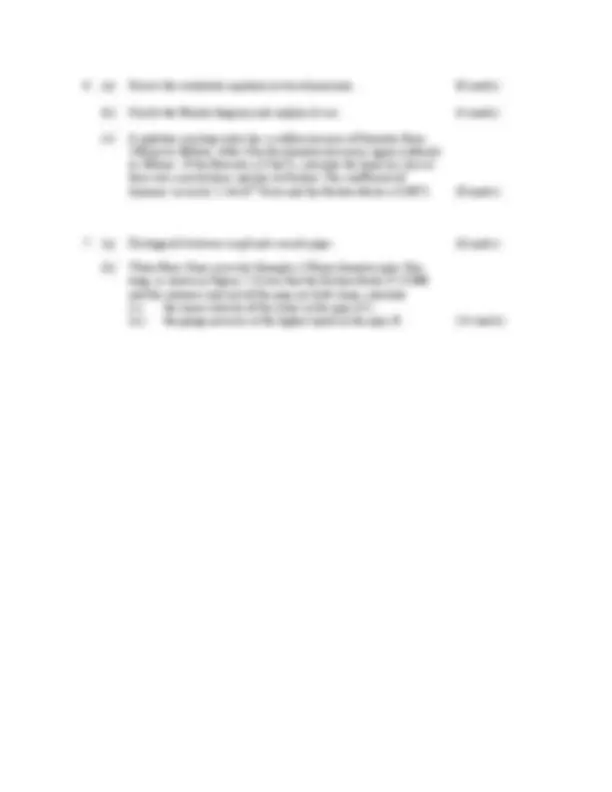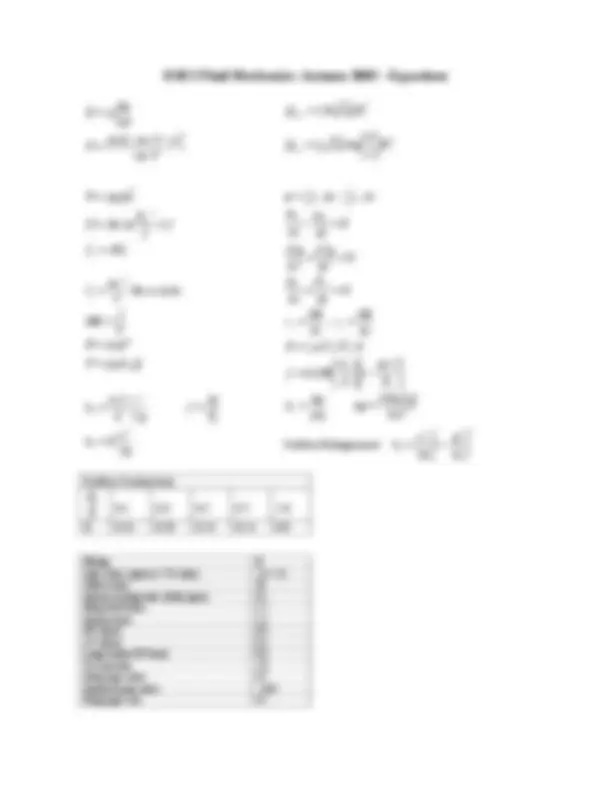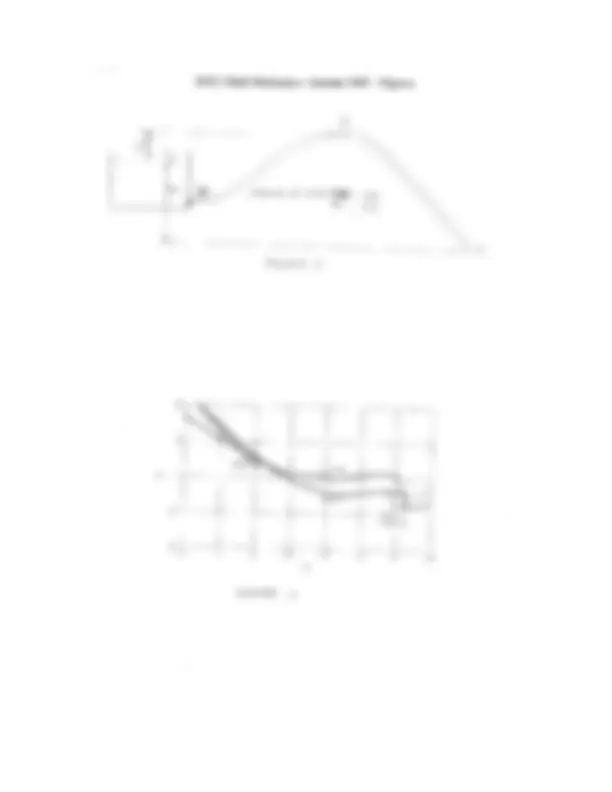





Study with the several resources on Docsity

Earn points by helping other students or get them with a premium plan


Prepare for your exams
Study with the several resources on Docsity

Earn points to download
Earn points by helping other students or get them with a premium plan
Community
Ask the community for help and clear up your study doubts
Discover the best universities in your country according to Docsity users
Free resources
Download our free guides on studying techniques, anxiety management strategies, and thesis advice from Docsity tutors
Main points of this past exam are: Direction of Resultant Force, Bluff Body and Streamlining, Indicial Method, Coefficient of Dynamic Viscosity, Bulk Modulus, Incompressible Flow, Immersed Bodies, Deformational Flow, Stream Function
Typology: Exams
1 / 5

This page cannot be seen from the preview
Don't miss anything!




Programmable calculators are not permitted Answer Five Questions Only Attachments include figures and equations
Examiners: Dr. E. Hitching Mr. T. Corcoran Mr. Prof. P. O’Donoghue
1 (a) A cylindrical buoy is 2.05m in diameter, 1.3m high and weighs15.2kN. It floats in salt water of density 1025kg/m^3. Its centre of gravity is 0.65m above the bottom. If a cylindrical load of 2kN is placed on the top, find the maximum height of the centre of gravity of the added load above the bottom if the buoy is to remain in stable equilibrium. Note that the cylindrical buoy and the added cylindrical load are aligned along the same axis. (12 marks)
(b) A hydraulic jack uses oil of mass density 930kg/m^3 to lift a load W. A force P of 900N is applied to the smaller cylinder, of cross-sectional area a = 18cm^2. The area A of the large piston is 240cm^2. What load can be lifted by the larger piston (i) if the pistons are at the same level? (ii) if the large piston is 0.5m below the smaller? (8 marks)
2 (a) Develop the equation for the flow through a large orifice. (8 marks)
(b) A horizontal pipe carrying water at a rate of 6m^3 /s is deflected through an angle θ = 50° from its original direction as its cross- sectional area is expanding. It enters the bend with a mean velocity of 28m/s and leaves with a mean velocity of 21m/s. If the pressure at the upstream end of the pipe is 750kN, calculate the magnitude and direction of the resultant force on the pipe. (12 marks)
3 (a) With reference to incompressible flow around immersed bodies, explain the terms: bluff body and streamlining. Illustrate your answer. (6 marks)
(b) Using Dimensional Analysis, by the indicial method , show that a relationship between the resistance to motion (R) of a body moving partially submerged through a viscous compressible fluid of density (ρ) and coefficient of dynamic viscosity (μ) with a uniform velocity (V) is related to these parameters and also to the size of the body (characteristic length l), bulk modulus of the fluid (K) and the acceleration due to gravity (g) can take the form below:
− p − q − r V K
Vl V R V l
(^22) 2 2 μ ρ lg
ρ ρ
4 (a) Show, with the aid of diagrams, the difference between translational, rotational and deformational flow. (6 marks)
(b) In a two-dimensional, incompressible flow field the velocity components in the x- and y-directions are as follows: Vx =6x-2y Vy=-2x-6y (i.) Does this flow satisfy the continuity equation? (ii.) What is the stream function? (iii.) What is the flow potential at a point (x,y)=(1,2)? (14 marks)
5 (a) Assuming that the resistance to movement of a hydroplane through water is mainly governed by the Froude number, defined as follows:
lg
v Fr = , calculate the resistance of a full-scale hydroplane if 1/
scale model tests show a model resistance of 2.4N at a velocity of
(8 marks) (b) Telephone poles are spaced a distance 50m apart and carry two cables each. Cable diameter is 8mm and the wind velocity is 30km/h. If the density and viscosity of air are 1.2kg/m^3 and 1.07 x 10-5^ Ns/m^2 respectively, calculate the drag force on each pole. Cd can be evaluated from Figure 1 below. (8 marks)
(c) Define quasi-steady flow and give an example of where it applies. (4 marks)
p K^2
3 Qrect = 32 B 2 gH r
cos
av cos u^2 P
5 2
Qvee (^) 158 2 g tan H v
y y
D = Sin G^ +
2
y
v x
v (^) y x
2 IG = Ak G 0 2
2 2
∂
x y
r^4 I (^) o
= for a circle = 0 ∂
y
v x
v (^) x y
x
v (^) x ∂
y
v (^) y ∂
d R e
f
g
v d
fl h (^) f 2
R e
f
g
p h (^) f ρ
d
lQ p π
μ ∆ =
g
u hL K 2
2 = (^) Sudden Enlargement:
2
2
1
2 1 2
g
u hL
Sudden Contraction:
1
2 A
Fitting K Gate valve (open to 75% shut) .25→ 25 Globe valve 10 Spherical plug valve (fully open) 0. Pump foot valve 1. Return bend 2. 90º elbow 0. 45º elbow 0. Large-radius 90º bend 0. Tee junction 1. Sharp pipe entry 0. Radiused pipe entry →0. Sharp pipe exit 0.